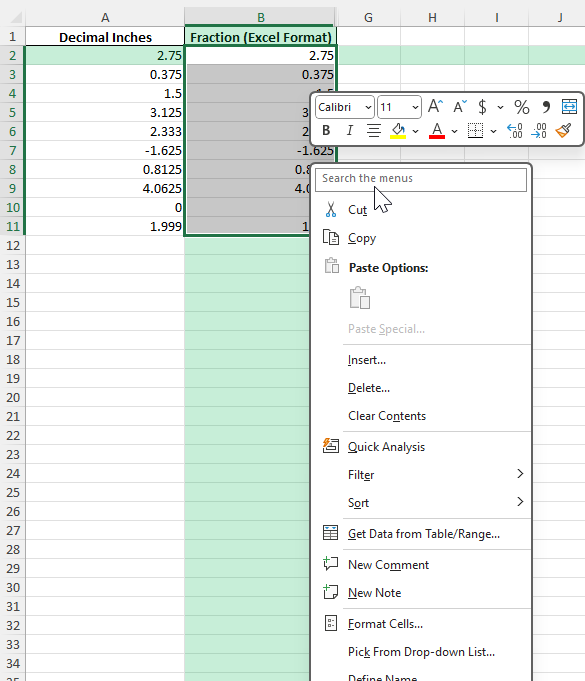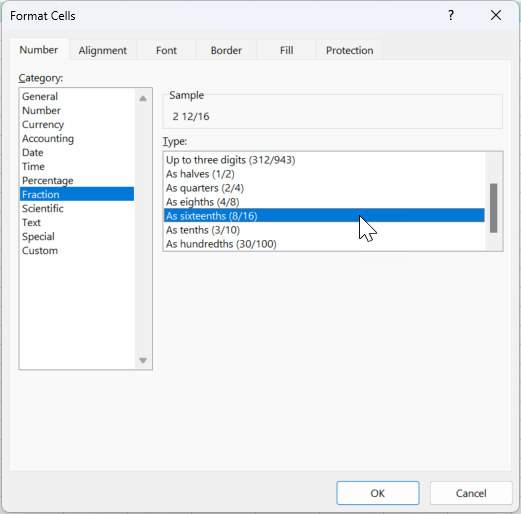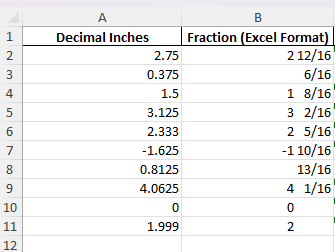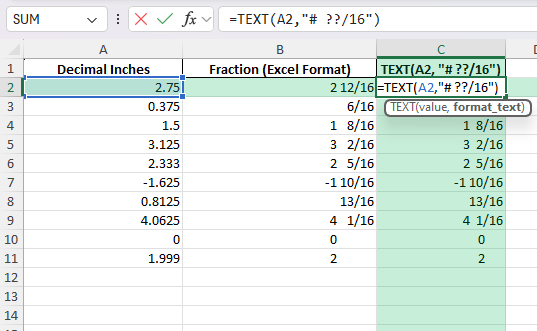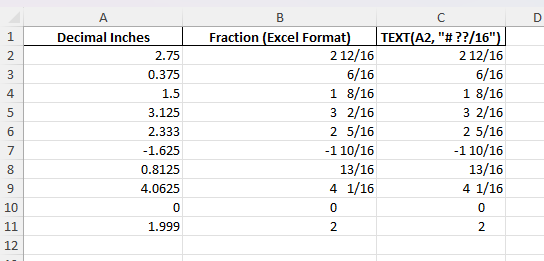If you work with measurements, woodworking, construction, or manufacturing, you often need to show values as fractions of an inch instead of decimals. Excel makes it easy to convert decimal inch values like 3.25 or 0.375 into readable fractions like 3 1/4 or 3/8. This helps communicate precise dimensions clearly, meets industry standards, and reduces rounding errors in reports or prints. In this guide, you’ll learn all the methods to convert and display decimals as fractions of an inch, plus advanced tips for automation and formatting.
Key Takeaways
- Excel can display decimals as fractions (e.g., 0.375 as 3/8) with custom number formatting.
- Use the Fraction number format for whole or mixed numbers (like 1 1/2 or 2 5/16).
- The
TEXT()function can convert a decimal to a text-based fraction in a formula. - You can set denominators for halves, quarters, eighths, sixteenths, and more.
- VBA and Power Query allow batch conversion or special rounding for custom denominators.
Table of Contents
About Decimal and Fraction Inches in Excel
Decimal inches (like 1.75) are common in calculations, but many industries require fractions (like 1 3/4) for communication, ordering, and documentation. Excel supports both, so you can convert easily and display data the way your audience needs.
3.25 → 3 1/4
0.625 → 5/8
2.3125 → 2 5/16
You can convert decimals to fractions using built-in formatting, formulas, or automation for batches of measurements.
Understanding Decimal and Fractional Notations
What are Decimal Inches?
Decimal inches are a way of expressing measurements where the inch is represented in decimal form rather than fractions. For example, 1.25 inches is a decimal representation, meaning one inch and a quarter of another. This notation is prevalent in various fields where precise measurement is crucial and often preferred for its ease of mathematical operations.
How Fractions Represent Measurements
Fractions represent measurements by dividing an inch into smaller, equal parts, with the numerator showing how many parts are considered and the denominator showing how many parts make up a whole. For example, 1/4 inch signifies one part of four equal sections of an inch. This method is especially useful in fields that require precision and clarity, such as woodworking and tailoring.
Comparison: Decimal vs. Fractional Representation
Decimals and fractions both measure the same but differ in format. Decimal representation, like 0.75 inches, is straightforward and often more precise, making calculations faster and less error-prone. Fractions, such as 3/4 inch, offer clarity in visual scaling and are common in everyday use, especially when specific standard sizes are known. While decimals simplify arithmetic, fractions provide a clear picture of relative sizes.
How to Convert Decimal to Fraction Inches in Excel
Step 1: Enter Your Decimal Inch Values
Type your decimal inch values in column A (e.g., 2.75, 0.375, 1.5).
Step 2: Format Numbers as Fractions
Select the cells with decimal values.
Right-click and choose Format Cells > Number tab.
Select Fraction.
Choose a type, such as “Up to one digit (1/4),” “Up to two digits (21/25),” or “As sixteenths (8/16).”
Click OK. Your decimals will now show as fractions.
Step 3: Use the TEXT Function for Fraction Output
To show a fraction in a cell as text, use:
=TEXT(A2,"# ?/?")
This converts 2.75 to “2 3/4”.
For sixteenths, use:
=TEXT(A2,"# ??/16")
This forces denominators to 16 (e.g., 0.375 to “6/16”).
Common Mistakes and Tips
Mistake: Not formatting as Fraction
Leaving numbers in General or Number format won’t show the fraction.
Mistake: Incorrect denominator
If your industry uses 1/16, don’t use “Up to one digit (1/4)” in formatting. Pick the correct fraction format.
Tip: Use formulas to round to the nearest fraction
To round 2.78 to the nearest 1/16, use:
=MROUND(A2*16,1)/16
Tip: Combine whole and fractional parts in a formula
=INT(A2)&" "&TEXT(A2-INT(A2),"?/16")
Tip: Use helper columns for flexibility
Store raw decimals, fractions, and rounded values in separate columns.
Bonus Tips and Advanced Scenarios
VBA Macro for Custom Fraction Display
Function DecimalToFraction(val As Double, denominator As Integer) As String
Dim wholeNum As Integer
Dim numer As Integer
wholeNum = Int(val)
numer = Application.WorksheetFunction.MRound((val - wholeNum) * denominator, 1)
If numer = 0 Then
DecimalToFraction = wholeNum
ElseIf wholeNum = 0 Then
DecimalToFraction = numer & "/" & denominator
Else
DecimalToFraction = wholeNum & " " & numer & "/" & denominator
End If
End Function
Use =DecimalToFraction(A2,16) for rounding to the nearest sixteenth.
Power Query for Batch Conversion
Add a custom column:
Number.Round([Inches]*16)/16
Then extract whole and fraction parts using Power Query text functions.
Combine Units (e.g., Feet and Inches)
Use formulas to convert decimal feet to feet-inches-fraction if needed.
Real-World Applications of Fractional Inch Conversions
Construction and Architecture
In construction and architecture, precise measurements are paramount, making the conversion of decimals to fractional inches a critical task. Excel aids professionals by swiftly converting and organizing detailed measurements, ensuring precision in blueprints and material specifications. By doing so, Excel enhances project accuracy, facilitates communication among teams, and helps prevent costly errors.
Engineering and Manufacturing
Engineering and manufacturing industries rely heavily on accuracy and standardization, where even minor discrepancies can lead to significant issues. Excel assists in these fields by converting decimal measurements to fractional inches, aligning seamlessly with the common use of fractional units in machinery and component specifications. This ensures components fit together perfectly and meet industry standards. Excel’s ability to handle large data sets efficiently further supports mass production efforts.
DIY Projects and Hobbies
For DIY enthusiasts and hobbyists, Excel offers a simple solution to convert decimal inches into fractions, enhancing precision in projects like woodworking or sewing. This conversion helps ensure that measurements align correctly, reducing material waste and project frustration. With Excel, you can plan and execute your projects with confidence, knowing each component fits as intended. This makes Excel an invaluable tool for hobbyists seeking professional results.
FAQ
Q: What is the quickest way to convert decimal to fraction in Excel?
A: Use the Fraction number format or the TEXT() formula.
Q: Can I set my own denominator (like 1/8 or 1/16)?
A: Yes, use “As eighths” or “As sixteenths” in Format Cells, or =TEXT(A2,"# ??/16").
Q: How do I round decimals to the nearest fraction?
A: Use =MROUND(A2*16,1)/16 to round to the nearest sixteenth, for example.
Q: How can I automate batch conversion?
A: Use Power Query or the VBA macro above.
Q: Will this work with negative numbers?
A: Yes, Excel handles negatives with both format and formulas.
John Michaloudis is a former accountant and finance analyst at General Electric, a Microsoft MVP since 2020, an Amazon #1 bestselling author of 4 Microsoft Excel books and teacher of Microsoft Excel & Office over at his flagship MyExcelOnline Academy Online Course.

